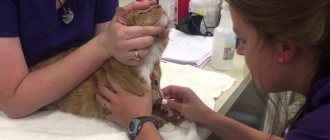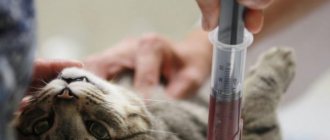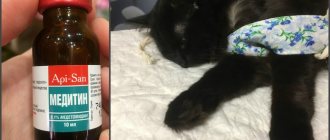The material was prepared in collaboration with the laboratory of the Dog and Cat International Exhibition Center
The collection of biomaterial from cats, dogs, rabbits, ferrets, guinea pigs is carried out from the veins of the limbs, as well as the neck:
- internal femoral vein or anterior saphenous vein of the forearm;
- lateral saphenous vein of the leg (in dogs);
- jugular vein in the neck.
Blood is taken from the dog in a sitting position or lying on its side. Taking blood from a vein from a cat is most often done with the patient restrained while lying on his side.
Taking blood from animals from the jugular vein is often easier and faster due to the rapid flow of blood in the vein.
Blood collection from birds is different from other animal species. Blood from the bird is taken from the wing vein or jugular vein.
Why and why you need to do a biochemical blood test in cats
To fully answer the question posed, one thing should be understood - the internal processes occurring in the animal’s body are influenced by everything, from the selection of food that it eats to its habitat. If we consider the issue of food, the situation today looks like this: a large number of breeders do not know how to select it on their own. And, since they also do not have the time or desire to consult with more experienced specialists, the food chosen “for luck” ultimately turns out to be completely different from what the animal needs for normal metabolic processes. The saddest thing is that it is not possible to see any changes in the animal’s behavior right away, so time will play against you. For this reason, a biochemical blood test is needed and should be performed so that your cat can avoid a number of negative consequences.
If we talk about a simple, routine blood test, then its data will not be able to clarify the picture. Of course, if you come across an experienced specialist with experience, he will be able to determine, based on the data obtained, for example, a lack of iron in the animal’s body, but there are very, very few of them today. It should be remembered that animal analysis is taken strictly on an empty stomach.
Now there is a clear awareness that a biochemical blood test in cats is a very important factor for identifying certain disorders in the condition of their body.
Our veterinarian will be happy to help you with making a diagnosis and taking biomaterial, the main thing is to contact us in time.
We have indicated veterinary prices for biochemical blood tests in the table below:
| Study | Price, rub | Production time |
| Biochemical blood test for cats - 1 indicator | 200 | 1 working day |
| Biochemical blood test for cats - standard profile (12 indicators) | 1500 | 1 working day |
| Urgent biochemical blood test for cats - standard profile (12 indicators) | 2300 | up to 3 hours |
| Biochemical blood test for cats - extended profile (24 indicators) | 2500 | 1 working day |
Types and forms of leukemia
An animal may have one or more retrovirus strains: A, B, C or T.
Depending on the state of immunity, leukemia in cats can occur in several forms:
- Transient (temporary). The initial period of the disease, until leukemia affects the bone marrow. At this stage, in rare cases, a strong immune system can develop a powerful response and destroy the pathogen completely. Such an animal receives lifelong immunity against viral leukemia. Typically, no more than two months pass from the onset of the disease, and these cats do not become a source of danger to others.
- Latent . This variety can occur when the immune system is strong. Replications of the virus are already present in the tissue structure, but the infection cannot multiply and become active. The animal remains a carrier, it may feel great, however, it poses a danger to healthy fellow tribesmen.
- A persistent or replication form of a viral organism. The weakened immune system no longer resists the penetration of the virus into the bone marrow structure. Signs of leukemia increase, primarily anemia. Particular harm is caused to the gastrointestinal tract, skin, bladder, and respiratory system.
What does a biochemical blood test mean in cats?
Specifics never hurt. And you, as the owner, will be more calm if you know what is hidden under this concept. A biochemical blood test in cats is a diagnostic method, thanks to which it is possible to characterize the functional characteristics of the pet’s organs, plus, of course, organ systems. To put it even more simply, the analysis perfectly shows how the animal’s body “works.” Looking ahead a little, it should be said that the interpretation of the biochemistry analysis itself is based on the ratio of enzymes, namely substances that accelerate metabolic reactions and substrates - substances that “modify” the enzyme.
After a venous blood sample
, it will be labeled and sent for examination. If blood is taken from the animal during the treatment itself, then this is necessary in order to track the dynamics of treatment. Correct something in the prescribed medications, maybe cancel something and generally see how the treatment course is going.
Biochemical blood test in cats. What enzymes does animal blood contain?
The body, as a separate, complex, integral system, contains a number of enzymes, each responsible for something. Let's take a closer look at what enzymes a cat's blood contains :
1
Alanine aminotransferase (ALT) - this enzyme is located among the cells of the animal’s liver, as well as the myocardium, and muscles of the body. It takes an active part in the metabolism of amino acids. 2 Aspartate aminotransferase (AST) is an intracellular enzyme that serves to transfer amino groups within the cells themselves. Large amounts of this enzyme are found in skeletal muscles, liver, brain, and, of course, the heart. When the cells of the enzyme begin to be damaged, it begins to be released, thereby entering the animal’s bloodstream. 3 Creatine phosphokinase (CPK, CK) is an incredibly important indicator when diagnosing diseases of organs such as the brain and heart. 4 Alkaline phosphatase (ALP) - an enzyme observed in the cells of the liver, placenta, intestines, and also bone tissue. Attention! The indicator increases if the analysis is performed on kittens, and this is the norm. 5 Alpha amylase - this enzyme is a digestive enzyme.
It is produced by the animal's pancreas; some of it can be found among the tissues: ovaries, intestines, and less often - muscles. An incredibly important step in almost any research will be what its results show. That is, what data, because the diagnosis by the veterinarian will depend on it. To do this, you need to be able to decipher it correctly, and this also takes time. If you don't want to waste precious minutes
, our veterinary clinic “YA-VET” offers a service - calling a veterinary doctor to your home. The arriving specialist will also present all documents and licenses upon your request, then you will certainly be calm that you are entrusting the animal to the hands of a trusted specialist.
If the blood test for biochemistry is correctly deciphered, it will give that treasured key that will lead to knowledge of the complete state of the pet’s body.
What causes the development of leukemia and what is its danger
The causative agent of the disease is an RNA-containing oncogenic retrovirus, which invades blood cells and destroys their genetic code. The Latin name is Feline leukemia virus. It was identified by scientists in Glasgow in 1964. Scientists have established a connection between cases of cancer of the blood and lymphatic system in cats with the detection of strains of this virus in their blood.
The virus is dangerous due to its oncogenicity and changes in blood composition, reducing the resistance of the cat’s body, and provoking secondary diseases. It begins its activity in the tonsils and lymphatic tissues of the nasopharynx, gradually spreading to the lymph, circulatory system, and brain.
Immune deficiency increases unnoticed. When the process spreads to the bone marrow, it is too late to fight, since the affected bone marrow produces more and more replicas of the virus along with blood cells, and leukocytosis progresses. Death usually occurs from diseases associated with hemoblastosis.
How to decipher a biochemical blood test in cats
First, close attention is paid to the condition of the animal’s kidneys.
The first thing that a biochemical analysis determines in cats is the condition of the kidneys
1Urea - if this indicator is increased, then the animal has renal disharmony, dehydration is present, this can be caused by a state of shock, or heart disease, a large amount of protein that penetrates along with food. If, on the contrary, the indicator is low, this may indicate edema. The norm for this indicator in the analysis: five – eleven mol/l. 2Creatinine - the indicator decreases if the body has ailments accompanied by polydipsia. Also, this indicator always responds to changes in the condition of the kidneys. The normal value is 130 µm/l. 3Phosphorus – the indicator will be overestimated in case of kidney diseases, or if any of the gastrointestinal tract pathologies are present in the pet’s body. At the same time, the indicator can be increased several times if the excretory system does not cope with its task. The same applies to the situation when the indicator is low, this may indicate kidney disease. The norm is 1.1 – 2.3 mmol/l. 4Calcium – it wouldn’t hurt to find out what level of calcium your pet’s blood contains, because most often when deciphering the analysis, the veterinarian turns his attention to the ratio of phosphorus-calcium indicators. Why? If the indicator is increased, then we can talk about an inflammatory process occurring in the kidneys, and it can also talk about poisoning. A decrease in the level of the indicator will indicate that, most likely, there has been a malfunction of the parathyroid gland. In a healthy cat, the level is 2.0 – 2.7 mmol/l.
The second thing that a biochemical blood test in cats will show is liver function.
After the indicators responsible for the functioning of the kidneys have been deciphered, the specialist begins to decipher those indicators that are responsible for the normal functioning of the liver, namely:
1Aspartate aminotransferase (AST) - the indicator is increased in case of really serious illnesses affecting the animal’s liver. The norm here is: 9.2 – 39.5 U/l. 2ALKP (alkaline phosphatase) - if the numbers are elevated, this indicates congestion in the cat’s gall bladder. 3Albumin - increases with fairly significant dehydration of the body. While its decrease indicates that the liver, stomach or intestines are not functioning properly. The normal value for this indicator is 25-39 g/l. 4An increased level of bilirubin in an animal will indicate that there are problems in the functioning of the biliary tract. May indicate a medical condition such as anemia. The normal bilirubin level should be 1.2 – 7.9 µm/l. 5 As for the level of bile acids, the situation here looks like this: if there are a lot of them, then there are disturbances in the functioning of the liver. The higher the indicator is from the normal level, the more serious the problem, and, therefore, the more dangerous. Sometimes not only for the normal functioning of the body, but also for its life in general.
Other indicators in decoding - biochemical analysis of the cat
1Glucose is another important component of the analysis, because its level clearly indicates the possible development of diabetes in a pet if the level is elevated. And also the lack of sufficient, balanced nutrition for the animal. The normal glucose level is 3.3-6.3 mmol/l. 2Lipase is an enzyme secreted by the pancreas of an animal. Its normal values are 50 U/l. If the indicator is higher, the pet’s body may have ailments such as pancreatitis and obesity. If the indicator is at the lower level, this may indicate that the animal’s diet is full of fats, they need to be reduced. 3The cholesterol norm is two to six mmol/l. If the indicator is elevated, this indicates problems with the liver, hypothyroidism – that is, an insufficient amount of hormones produced by the animal’s thyroid gland. When the indicator, on the contrary, turns out to be lower, this will indicate starvation, or, alternatively, some kind of neoplasm.
What symptoms indicate the disease?
The manifestation of signs such as bleeding from the gums or bruises on the skin indicate the development of pathology.
If a cat develops this pathological condition, the pet owner may notice the following signs:
- apathy;
- loss of appetite;
- lethargy;
- the appearance of pinpoint bruises on the skin and mucous membranes;
- the occurrence of hematomas for no apparent reason in the peritoneum and groin area;
- bleeding from the gums;
- blanching of the mucous membranes;
- frequent nosebleeds;
- impurities in fecal blood.
Bottom line. Biochemical blood test in cats
Produce detailed and high-quality transcription
such a complex and multi-level analysis as the biochemistry of an animal’s blood
must be performed by a specialist
! Our veterinary clinic “YA-VET” is filled with professionals in their field.
When you turn to us for help, you always receive first-class help, support, and a lot of practical advice. Our level of service and examination is very high; in our work we use the best and newest equipment, which also increases professionalism and accuracy in making diagnoses. The animal that lives in your home has its own history, let it extend it by living for many, many more years.
Now, having read the data in the article in its entirety, you understand how valuable normal biochemical blood test values are in your cats!
Why is it dangerous to neglect treatment for leukemia?
Lack of treatment is fraught with the development of the disease and its accompanying pathologies, which lead to death. An animal that does not receive veterinary care develops:
- anemia;
- spontaneous bleeding;
- chronic cystitis;
- constant low-grade fever;
- bacterial infections;
- viral respiratory diseases;
- peritonitis;
- ascites;
- toxoplasmosis;
- autoimmune glomerulonephritis;
- stillbirth;
- damage to the mammary glands in females;
- miscarriages;
- fetal resorption and fading kitten syndrome;
- sarcoma of the lymphatic system.











